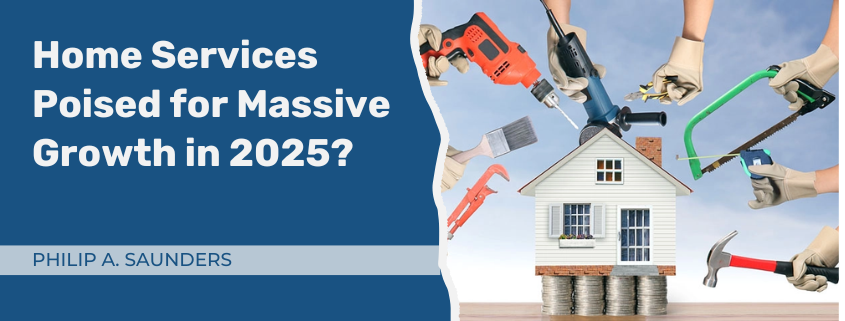Fed Rate Cuts Poised to Drive Home Services Growth Heading into 2025
The U.S. Federal Reserve’s decision to cut interest rates by half a percentage point last week had an immediate positive impact on the stock prices of major home improvement retailers like Home Depot and Lowe’s. Both companies have seen their share price rise, reflecting investor confidence in the potential for increased consumer spending on home projects.
This uptick in stock performance could signal a promising outlook for home services companies, suggesting that they too could experience significant growth and demand as lower interest rates make financing home services more accessible and affordable for consumers. Let’s take a closer look:
Lower Interest Rates Drive Increased Consumer Spending on Home Services
Lower interest rates reduce the cost of borrowing, making it more affordable for consumers to finance home improvement and maintenance projects. High-interest rates often deter homeowners from taking out loans or using credit for significant expenditures due to the increased repayment burden. However, a reduction in interest rates alleviates this financial strain, encouraging homeowners to embark on both planned and unplanned home services projects.
Enhanced Affordability and Accessibility for Home Services
With reduced borrowing costs, consumers can allocate more funds toward essential home services such as plumbing, electrical work, HVAC installations, landscaping, and general maintenance. This enhanced affordability not only increases the frequency of smaller, routine projects but also paves the way for larger, more comprehensive renovations. Consequently, home services companies can anticipate a surge in demand, translating to higher revenues and expanded business operations.
Shifting Consumer Spending Patterns in Home Services
Historical data underscores the correlation between lower interest rates and increased consumer spending in the home sector. For instance, following previous rate cuts, companies like Home Depot and Lowe’s experienced notable upticks in sales and stock prices. I expect this trend to also play out in the home services industry, where increased consumer spending can lead to business growth in 2025.
Unlocking Pent-Up Demand in the Home Services Market
The home services industry has seen a significant accumulation of deferred projects, particularly during periods of economic uncertainty and high-interest rates. Homeowners often postpone non-essential repairs and improvements until financial conditions become more favorable. The recent rate cut could act as a catalyst to release this pent-up demand, enabling homeowners to finally address long-overdue maintenance and upgrade projects.
Comprehensive Service Offerings for Diverse Needs
Home services companies that offer a wide range of services—from minor repairs to major renovations—are well-positioned to capitalize on a lower rate environment. The ability to cater to both small-scale and large-scale projects ensures that businesses can attract a diverse customer base, maximizing revenue opportunities. Additionally, companies can leverage this opportunity to introduce new services or enhance existing offerings, further meeting the evolving needs of consumers.
Expanding Market Penetration and Service Reach
Unlocking pent-up demand also opens avenues for market penetration and expansion. Home services companies can explore untapped markets or underserved regions, leveraging increased consumer spending to establish a stronger presence. Strategic marketing campaigns and targeted promotions can effectively capture the attention of homeowners ready to invest in their properties, driving business growth and market share.
Boosting Consumer Confidence and Mobility in Homeownership
Fed Chair Jerome Powell highlighted that lower interest rates are expected to stimulate the housing market by encouraging more people to buy and sell homes. Increased mobility in the housing market directly impacts the home services industry, as new homeowners often require a suite of services to customize and maintain their properties.
Enhancing Homeownership and Renovation Activities
As interest rates decline, homeownership becomes more attainable for a broader segment of the population. New homeowners are more likely to invest in personalized home services to tailor their living spaces to their preferences. Additionally, existing homeowners may feel more confident undertaking renovations, knowing that the financial environment is favorable. This dual impact of increased home purchases and renovations drives demand for home services, fostering a thriving market.
Psychological Shift Towards Home Investment
Lower interest rates also have a psychological effect on consumer behavior. When borrowing costs decrease, consumers are more inclined to make discretionary purchases, including home improvements and enhancements. This shift in mindset from saving to investing in one’s home can lead to a substantial increase in the volume and value of home services projects, benefiting companies in the sector.
Phased Recovery: Transitioning from Small Projects to Major Home Renovations
A phased recovery approach suggests that the home services industry will likely experience an initial surge in smaller projects as consumers ease into the market. These projects typically involve minor repairs, cosmetic upgrades, and routine maintenance, which require less financial commitment and can be completed relatively quickly.
Gradual Shift to Large-Scale Home Renovations
As economic conditions continue to improve and consumer confidence strengthens, the market is expected to transition from smaller projects to more substantial renovations. Larger projects, such as kitchen remodels, window replacement, bathroom upgrades, and extensive landscaping, require more significant investment and planning. Home services companies that have successfully managed the influx of smaller projects will be well-prepared to handle larger, more complex jobs, thereby driving further growth and profitability.
Building Long-Term Relationships Through Diverse Projects
Engaging consumers with smaller projects provides an opportunity for home services companies to build long-term relationships with clients. Satisfied customers are more likely to return for future projects and recommend services to others, creating a loyal customer base. This phased approach not only ensures a steady revenue stream but also fosters trust and reliability, essential elements for sustained business success.
The Potential for Further Rate Cuts and Continued Growth in Home Services
Fed Chair Jerome Powell indicated the possibility of additional rate cuts if economic data supports such measures. The prospect of further reductions in interest rates can act as an ongoing incentive for consumers to engage in home services projects.
Strategic Financial Planning for Homeowners
The expectation of future rate cuts allows consumers to strategically plan their home services expenditures. Homeowners may opt to take out new mortgages or credit lines, knowing they can refinance at more advantageous rates later. This proactive financial planning can lead to an increase in current spending on home services, as consumers take advantage of the present lower rates to undertake necessary projects without hesitation.
Sustained Business Growth and Strategic Investments for Home Services Companies
For home services companies, the potential for further rate cuts signals a stable and growing market environment. Businesses can plan for sustained growth, investing in expanding their service offerings, enhancing operational efficiencies, and adopting new technologies to better serve their customers. Additionally, companies can allocate resources towards marketing and customer acquisition strategies, ensuring they remain competitive and responsive to market demands.
Adapting to Economic Trends for Long-Term Success
Home services companies that remain agile and responsive to economic trends will be best positioned to capitalize on the benefits of rate cuts. By closely monitoring interest rate movements and consumer behavior, businesses can adjust their strategies to align with market conditions. This adaptability ensures that companies can maintain momentum, even in the face of fluctuating economic landscapes, and continue to thrive in the long term.
Similar Posts:
- Surging Ahead: The Home Services Industry on Pace for Record Growth in 2024
- Garage Door Replacement Tops the List: Key Insights from the 2024 Cost vs. Value Report
- The Boomer Effect: Driving Demand in the Home Services Industry
Mr. Saunders serves as Mesa’s Vice President of Marketing, bringing with him a wealth of experience in strategic marketing and operations. In this role, Mr. Saunders is responsible for overseeing all marketing activities, utilizing a blend of traditional and digital strategies to enhance brand presence and profitability, managing a multi-million dollar marketing budget across various media platforms, and leading the continued implementation of CRM systems to streamline customer engagement and drive business growth.




Leave a Reply
Want to join the discussion?Feel free to contribute!